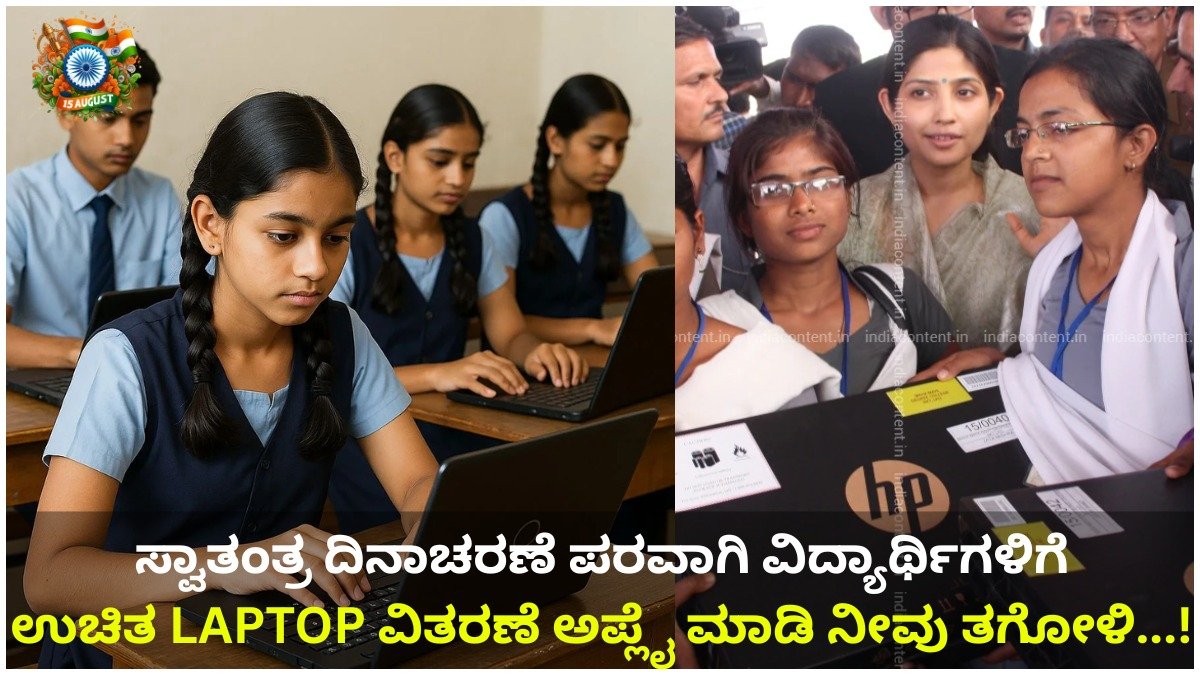In an age of rapid technological innovation, digital access has become a decisive factor in academic success. The onset of online education—exacerbated by the COVID‑19 pandemic—highlighted stark inequities in access to devices such as laptops and tablets. Students from economically disadvantaged and marginalized communities found themselves at a disadvantage without reliable hardware. In response, the Government of Karnataka initiated a visionary effort: the Free Laptop Scheme, aimed at bridging the digital chasm in higher education.
This scheme is particularly directed at enabling SC/ST, OBC, and low-income students by offering them access to a functional computing device. Beyond bridging gaps, it’s designed to open doors to higher education, online learning, and enhanced technical competence.
2. Purpose and Objectives
The scheme pursues multiple core goals:
- Promoting digital literacy among communities historically left on the educational sidelines.
- Encouraging enrollment in higher education, especially in technical and professional programs like engineering, medicine, and postgraduate courses.
- Equipping disadvantaged students with essential tools to navigate the demands of digital classrooms, project work, and self‑learning.
- Reducing dropout rates, especially in rural regions where lack of technology becomes a barrier.
- Leverage government investment to foster inclusion and innovation.
3. Scope and Scale of the Program
The scheme plans to serve *over 150,000 students, allocating nearly *₹299 crore** in budget. Laptops—typically recognized brands like HP or Acer—are provisioned with basic Intel or AMD processors and at least 2 GB of RAM. Distribution is carried out through participating government and aided colleges, coordinated with the Department of Collegiate Education and Social Welfare Department.
4. Eligibility Criteria
Prospective beneficiaries must meet several conditions:
- Karnataka residency: Applicants must be permanent residents of Karnataka.
- Social category: SC, ST, OBC, or from economically weaker sections.
- Academic achievement: Successful completion of Class 12 (PUC) with sufficient merit.
- Course enrollment: Must be enrolled in first year of:
- A degree (B.A., B.Sc., B.Com etc.)
- Engineering
- Medical (undergraduate)
- Polytechnic programs
- Post‑graduation (where applicable)
- Income threshold: Family income below ₹2.5 lakh/year (annual threshold may vary depending on the year’s rules).
5. Documents Required
Applicants need to submit the following:
- Aadhaar card (linked with bank account preferred)
- PUC/SSLC mark sheets
- Admission letter from the college
- Caste certificate (if applicable)
- Income certificate
- Domicile certificate (Karnataka residency proof)
- Passport‑size photograph
6. Application Steps
a. Online Application
- Visit the official Karnataka Department of Collegiate Education portal.
- Locate and download the Free Laptop Scheme application form.
- Fill out the form carefully with required personal and educational details.
- Upload the scanned copies of requested documents.
- Submit the form electronically and retain acknowledgment.
- Await verification and further updates from the department or college authorities.
b. Offline Application
Some colleges still accept paper applications:
- Obtain the printed application form either from the website or college office.
- Attach photocopies of required documents.
- Submit the completed application to the college’s designated counter or welfare office.
- Keep a submission receipt or acknowledgment slip.
Application windows typically open around June–July each academic year, though actual dates may vary. Always confirm with your college or the official website for annual updates.
7. Distribution Process
- Once applications undergo verification:
- Eligible students are shortlisted.
- The procurement of laptops occurs (often through government tenders).
- Colleges receive devices in batches.
- Distribution events are organized at college premises, often in coordination with welfare authorities.
- Devices are handed over to students, and records are maintained for accountability.
- Laptops are owned outright by the students; there is no requirement to return them after graduation.
8. Geographical Reach
The scheme operates throughout Karnataka, concentrating efforts in both urban and rural educational hubs. Key districts inclusive of the rollout are:
- Bangalore
- Mysore
- Mangalore
- Dharwad
- Hubballi
- Belagavi
- Tumkur
- Shimoga
- Kalaburagi (Gulbarga)
Colleges across these regions collaborate with respective district-level Social Welfare and Collegiate Education departments.
9. Benefits to Recipients
- Stable access to online classes and course materials.
- Improved productivity in assignments, research, and internships.
- Psychological uplift and reduced dropout risk through tangible support.
- Opportunity for self-directed learning: students can install educational tools and explore coding, software training, and more.
- Long-term asset: the laptop stays with the student—no post-graduation returns.
- Enhanced career prospects: students with digital access can better apply for internships, online courses, or employment.
10. Challenges and Limitations
Even with widespread positive outcomes, the program has encountered hurdles:
- Delay in distribution: procurement and logistical issues cause postponements.
- Insufficient funding: in some years, the allocated budget did not meet demand, leading to cuts in beneficiary numbers.
- Low-end machine specs: older models with limited RAM result in performance issues for modern software tools.
- Awareness gap in rural zones: remote areas sometimes lag in awareness of eligibility and application procedures.
- Application errors: incomplete documentation or late submissions lead to rejections.
11. Voices from Beneficiaries
Students across Karnataka have credited the scheme with steering their academic journey:
- Sangeeta K., Mysore (B.Sc.):
“This laptop helped me attend all my online classes during COVID‑19 and even learn coding online. I’m truly grateful.” - Rafiq A., Dharwad (Polytechnic):
“I couldn’t afford a laptop. This scheme changed my life and made me confident to apply for better internships.”
These testimonials underscore the life-changing impact of accessing technology through the scheme.
12. Frequently Asked Questions (FAQs)
Q: Can general-category students apply?
Mostly, the scheme targets SC/ST/OBC and economically weaker students. In some years, merit-based applicants from general categories have been considered—based on remaining slots and eligibility guidelines.
Q: Are there any charges involved?
No. The laptops are provided free of cost; beneficiaries are not required to pay a fee.
Q: Is online-only submission mandatory?
Not necessarily. Many colleges accept offline forms. Check with your college to clarify submission modality.
Q: Must the laptop be returned after study completion?
No. Ownership is transferred to the student permanently.
13. Recent Developments & Government Updates
As of mid‑2025, Karnataka’s government is reviewing the scheme’s impact and exploring revisions:
- Expanded eligibility: proposals are under discussion to widen the beneficiary base to include meritorious students not in reserved categories.
- Enhanced hardware: budget proposals for 2025–26 aim to offer devices with better specifications—like increased memory or faster processors—to support modern academic software.
- District outreach enhanced: improving awareness campaigns in rural districts and remote colleges.
- Digital education upskilling: training modules are being considered to help students make the most of their devices (e‑learning platforms, software literacy, etc.).
14. Tips for Prospective Applicants
- Check annual eligibility updates: income limits or merit criteria may adjust each year.
- Apply early: colleges process applications in the early part of the academic year—typically June or July.
- Verify document accuracy: missing or incorrect documents are the most common cause of disqualification.
- Keep copies of submissions: acknowledgment slips or digital receipts can be helpful if clerical issues arise.
- Follow up regularly: track updates via your college welfare office or departmental email/portal.
15. Broader Impact and Significance
This scheme goes beyond gifting laptops—it represents a structural boost to inclusivity and parity in education. By enabling more students to participate in the digital economy, it:
- Raises the quality of higher education participation across disadvantaged segments.
- Equips students for 21st-century learning: online courses, remote internships, digital portfolios.
- Fosters confidence to explore new academic and career pathways.
- Bridges socio-economic gaps: ensuring that class or caste does not limit access to knowledge.
16. Possible Areas for Improvement
To strengthen future rollout, authorities may consider the following:
- Upgrading specifications: including 4 GB or 8 GB RAM, SSD storage, pre‑loaded academic software or educational licenses.
- Including non-reserved yet low-income meritorious students.
- Introducing awareness camps—especially in aspirant-first-tier rural colleges.
- Facilitating training workshops on basic software tools, cybersecurity, and digital content creation.
- Monitoring and feedback systems: regular student surveys to assess satisfaction levels and tech issues.
17. Estimated Impact – Hypothetical Case Study
Student Profile
- Name: Priya
- Category: OBC
- Family income: ₹2 lakh/year
- Course: First-year B.E. at a government engineering college in Belagavi
Priya’s laptop enabled her to:
- Attend virtual lectures reliably, even from home.
- Download important courseware and manage assignments.
- Participate in online forums and coding bootcamps.
- File internship applications during vacation, leading to valuable real-world experience.
Without this device, she might have faced skips in coursework or missed out on digital learning—reflecting the tangible power such schemes hold.
18. Final Thoughts
Karnataka’s Free Laptop Scheme is a powerful enhancer of educational opportunity. It transforms a simple device into a keystone of digital inclusion, enabling students from weaker socio-economic backgrounds to pursue knowledge, build competencies, and envision brighter futures. As the program evolves—potentially expanding eligibility and upgrading hardware—it stands as a beacon of state-led empowerment.
For students and stakeholders, staying informed about annual updates, preparing accurate documents, and applying on time are key to maximizing benefits. As more institutions join the network and the government enhances support, the scheme’s long‑term social impact promises to be far-reaching.











